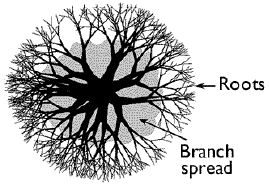|
How to Fertilize a Tree
The main reason to fertilize trees and shrubs is to bolster their health so they are better prepared to fight off pests, disease, and environmental stresses. While fertilizer can't solve all of a tree's problems, it will go a long way to give it a fighting chance. |
When Should I Fertilize My Tree?
A good time to fertilize trees in most Northern temperate climates is from fall to mid-spring. At these times the tree's roots take the nutrients from the soil and apply them to important health-promoting functions such as root development and disease resistance, rather than simply putting out new growth.

During the growing season, fertilizing can help a tree overcome mineral deficiencies and fight off infections.
If you are fertilizing in mid- to late summer, avoid formulations high in nitrogen as this will just promote weak, new growth that may be easily damaged in the winter |
.Where Do I Put The Fertilizer?
The objective of fertilization is to put the nutrients where they will best be taken up by the tree's roots. Therefore, it is necessary to fertilize throughout the entire root system. In general, the roots extend well beyond the outer reach of a tree's branches.
The fertilizer must also be placed underneath the roots of any competing plants such as grass or other ground cover. Spreading granular fertilizer on the lawn might make your grass greener, but it will likely not help your tree.
All fertilizer labels have three bold numbers. The first number is the amount of nitrogen (N), the second number is the amount of phosphate (P2O5) and the third number is the amount of potash (K2O). These three numbers represent the primary nutrients (nitrogen(N) - phosphorus(P) - potassium(K)).
This label, known as the fertilizer grade, is a national standard.
A bag of 10-10-10 fertilizer contains 10 percent nitrogen, 10 percent phosphate and 10 percent potash.
Fertilizer grades are made by mixing two or more nutrient sources together to form a blend, that is why they are called "mixed fertilizers." Blends contain particles of more than one color. Manufacturers produce different grades for the many types of plants.
You can also get fertilizers that contain only one of each of the primary nutrients. Nitrogen sources include ammonium nitrate (33.5-0-0), urea nitrogen (46-0-0), sodium nitrate (16-0-0) and liquid nitrogen (30-0-0). Phosphorus is provided as 0-46-0 and potash as 0-0-60 or 0-0-50. |
A Basic Guide to Water Soluble Fertilizers.
Including information pertaining to it's contents and usages, as well as, how what's on the label can differ from what's inside.
Water soluble fertilizers are fertilizers that can be dissolved in water and added or leached out of the soil easily. With water soluble fertilizers it is easy to control the precise amount of nutrients available to your plants(the control is more exact with soilless mixes).
Soluble fertilizers usually have N-P-K numbers listed on their label. The numbers listed are not always the exact percentages, they are an indication of the smallest percentage that the fertilizer contains of the listed element. The reason for this is that companies do not want their competitors to know the exact amount of nutrients they have in their product, so they list the lowest levels their product might contain to thwart any copying of their secret growing compounds.
The N is for nitrogen, the P is for phosphorus and the K is for potassium or potash. Of the 16(12 of which are contained in water soluble fertlizers) known elements necessary for plant life, N-P-K, are the three that are of the most importance and always listed on water soluble fertilizers, in that order(except Eco-Grow, which lists N-K-P).
Following N-P-K, calcium(Ca) and magnesium(Mg) are the two, second most important nutrients listed on the label. The rest, iron(Fe), sulfur(S), manganese(Mn), boron(B), molybdenum(Mb), zinc(Zn) and copper(Cu) are trace elements or micro-nutrients. |
| |
Your Satisfaction is Guaranteed!
Order online or call 1-626-586-0581

|

